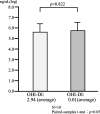Factors affecting the number of bacteria in saliva and oral care methods for the recovery of bacteria in contaminated saliva after brushing: a randomized controlled trial
- PMID: 38001433
- PMCID: PMC10675882
- DOI: 10.1186/s12903-023-03676-7
Factors affecting the number of bacteria in saliva and oral care methods for the recovery of bacteria in contaminated saliva after brushing: a randomized controlled trial
Abstract
Background: Oral care is important in preventing aspiration pneumonia in older adults. However, it is not clear what kind of oral care can reduce the number of bacteria in saliva. The purposes of this study are to clarify whether there is a relationship between plaque amounts and salivary bacterial counts, and how bacteria dispersed into the oral cavity by brushing can be reduced.
Methods: First, saliva samples were collected from 10 healthy adult volunteers after 30 h of unbrushing and after thorough brushing, and the total bacterial count was determined by real-time PCR. Next, 40 older adults attending an outpatient dental clinic were randomly assigned into two groups: a wiping group (20 patients) and a mouthwashing group (20 patients). Saliva was collected before and after brushing, and after wiping in the wiping group and after mouthwashing in the mouthwashing group, and the total bacterial count was quantified by real-time PCR.
Results: In a study of volunteers, there was no association between plaque amounts and salivary bacterial counts. In a study of older adult patients, salivary bacterial counts were significantly higher in patients with higher oral hygiene index and fewer remaining teeth. Brushing increased salivary bacterial counts. Wiping did not significantly reduce the number of bacteria, while mouthwash returned the increased number of bacteria after brushing to the pre-brushing level.
Conclusions: There is no direct relationship between the amount of plaque and the number of bacteria in saliva. Brushing disperses bacteria into the oral cavity, resulting in a marked increase in the number of bacteria in saliva. Wiping does not collect the dispersed bacteria, and it seems essential to rinse the mouth after brushing.
Trial registration: UMIN000045854.
Keywords: Bacterial counts; Brushing; Mouthwash; Oral care.
© 2023. The Author(s).
Conflict of interest statement
The authors declare no competing interests.
Figures
Similar articles
-
Brushing Methods for Patients Unable to Use a Mouthwash: A Preliminary Study of the Effects of Moisturizing Gel and Povidone-Iodine in Healthy Volunteers.Cureus. 2024 May 28;16(5):e61277. doi: 10.7759/cureus.61277. eCollection 2024 May. Cureus. 2024. PMID: 38947579 Free PMC article.
-
The effects of a zinc citrate dentifrice on bacteria found on oral surfaces.Oral Health Prev Dent. 2010;8(1):47-53. Oral Health Prev Dent. 2010. PMID: 20480054 Clinical Trial.
-
A Crossover Trial of a Novel Toothbrushing Method for Prevention of Aspiration Pneumonia: Toothpaste With Povidone-Iodine and Moisturizing Gel Mixture.Cureus. 2024 Dec 10;16(12):e75494. doi: 10.7759/cureus.75494. eCollection 2024 Dec. Cureus. 2024. PMID: 39803048 Free PMC article.
-
Short-term microbiological effects of scaling and root planing and essential-oils mouthwash in Chinese adults.J Zhejiang Univ Sci B. 2013 May;14(5):416-25. doi: 10.1631/jzus.B1200350. J Zhejiang Univ Sci B. 2013. PMID: 23645178 Free PMC article. Clinical Trial.
-
The efficacy of antimicrobial mouth rinses in oral health care.Bull Tokyo Dent Coll. 1998 Feb;39(1):7-14. Bull Tokyo Dent Coll. 1998. PMID: 9663026 Review.
Cited by
-
The prebiotic effect of 1-kestose in low-birth-weight neonates taking bifidobacteria: a pilot randomized trial in comparison with lactulose.Biosci Microbiota Food Health. 2024;43(4):329-335. doi: 10.12938/bmfh.2023-079. Epub 2024 May 20. Biosci Microbiota Food Health. 2024. PMID: 39364124 Free PMC article.
-
Oral care methods to reduce salivary bacteria in infants undergoing cardiac surgery: A randomized controlled trial.J Dent Sci. 2025 Jan;20(1):248-253. doi: 10.1016/j.jds.2024.07.035. Epub 2024 Aug 10. J Dent Sci. 2025. PMID: 39873064 Free PMC article.
-
Incorporating scale uncertainty in microbiome and gene expression analysis as an extension of normalization.Genome Biol. 2025 May 22;26(1):139. doi: 10.1186/s13059-025-03609-3. Genome Biol. 2025. PMID: 40405262 Free PMC article.
-
Brushing Methods for Patients Unable to Use a Mouthwash: A Preliminary Study of the Effects of Moisturizing Gel and Povidone-Iodine in Healthy Volunteers.Cureus. 2024 May 28;16(5):e61277. doi: 10.7759/cureus.61277. eCollection 2024 May. Cureus. 2024. PMID: 38947579 Free PMC article.
-
Effect of Stimulated Salivary Volume on Dysbiosis of the Salivary Microbiome in Children and Young Adults.Int Dent J. 2025 Jun;75(3):1759-1770. doi: 10.1016/j.identj.2025.03.015. Epub 2025 Apr 8. Int Dent J. 2025. PMID: 40203517 Free PMC article.
References
-
- Ministry of Health, Labour and Welfare: 2021 Summary of Vital Statistics Monthly Report (approximate figures). 2021.https://www.mhlw.go.jp/toukei/saikin/hw/jinkou/geppo/nengai21/dl/gaikyou.... Accessed 19 Apr 2022.
-
- Craven DE, Driks MR. Nosocomial pneumonia in the intubated patient. Semin Respir Infect. 1987;2:20–33. - PubMed
Publication types
MeSH terms
Substances
Grants and funding
LinkOut - more resources
Full Text Sources




